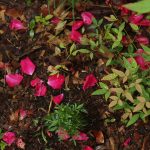Dreaming of a lounge-worthy, low maintenance landscape? A xeriscape may be the answer. Just keep these seven principles in mind.
Coined in 1981 by Denver Water, xeriscape (xeris is Greek for dry) refers to combining a low maintenance landscape with low water use.
A xeriscape is not rocks, decomposed granite, cactus, agaves, or rain barrels — although these could all be components of one. In its simplest form a xeriscape is minimal lawn, native flowering perennials and shrubs, mulch and other soil amendments, and pervious patios or decks.
There are seven principles of xeriscape.
- Planning and design
- Soil amendment
- Efficient irrigation
- Appropriate plant selection
- Mulch
- Limited lawn
- Appropriate maintenance
Let’s examine how these principles apply to our South Texas landscapes.
Planning and design
Consider aspect, shade, slope, soil, and existing and desired species. The goal is to approximate 1/3 lawn, 1/3 beds and 1/3 pervious patio or deck.
Soil amendments
One way to increase water holding capacity is to add amendments, such as compost. Add one inch of compost to the soil to beds in spring and fall and ¼ inch over lawns during the same seasons.
Efficient irrigation
Of course, the most efficient irrigation is rain, but we recommend using a hand-held hose or soaker hoses. In-ground irrigation system, on the other hand, use 50 percent more water (70 percent in the summer) than a hose-end sprinkler or hand-held hose.
Appropriate plant selection
Use native plants or ones well-adapted to our area. My personal favorites are salvias, firecracker fern, damianita, Turk’s cap, cenizo and iris. All of these are included in the WaterSaver Landscape Coupon.
Mulch
Two inches of mulch, whether organic like woodchips or river rock, is sufficient. Xeric plants prefer limited mulch (no more than ½ inch).
Limited lawn
Lawns use an excessive amount of water. By reducing the amount of lawn, you not only minimize mowing, but also significantly reduce how much water you use. As mentioned previously, the goal is 1/3 lawn. The maximum is ½ the landscape in lawn.
Appropriate maintenance
Excessive pruning and fertilizing does more harm than good. Keep it simple – mow weekly, prune perennials three times a year and trees once every five years, and fertilize with compost in spring and fall. Check out our handy maintenance section, broken down by month, plant type or topic.
An optional component of xeriscapes are patios and decks — they never need water! Our Outdoor Living Rebate can help you replace that thirsty lawn with a functional outdoor living space.
To see a true Texas xeriscape, visit one of our wonderful natural areas like Freidrich or Hardberger Parks.




